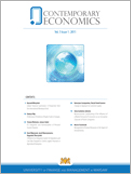Modelling Natural Capital: A Proposal for a Mixed Multi-criteria Approach to Assign Management Priorities to Ecosystem Services
Modelling Natural Capital: A Proposal for a Mixed Multi-criteria Approach to Assign Management Priorities to Ecosystem Services
Author(s): Mónica de Castro Pardo, Pascual Fernández Martínez, José Manuel Guaita Martínez, José María Martín MartínSubject(s): Energy and Environmental Studies, Public Administration, Human Ecology, Rural and urban sociology, Economic development, Environmental interactions, Accounting - Business Administration, Transport / Logistics
Published by: Akademia Ekonomiczno-Humanistyczna w Warszawie
Keywords: natural capital; ecosystem services; conservation management; AHP; GP;
Summary/Abstract: Investment in natural capital is increasingly necessary and urgent considering the increasing loss of global biodiversity and the associated social and economic losses. Ecosystem services are tools for quantifying the stock of natural capital and there is great concern about their assessment and valuation. However, there remains a substantial gap between the large amount of information available about ecosystem services and the information required to support decisions and this undermines the efficiency of their management. Multi-criteria analysis techniques can be very useful to efficiently develop decision-making processes to properly channel investment and optimize the costs associated with conservation. This paper proposes an innovative mixed methodology for multi-criteria analysis to assign priorities to ecosystem services in protected areas in terms of importance and vulnerability. The model was applied by a group of experts to prioritize 20 ecosystem services in the Ordesa and Monte Perdido National Park. In order to collect and analyze the individual valuations, a mixed method of Analytic Hierarchy Process (AHP) and Goal Programming (GP) was used, and to aggregate the valuation criteria, a Joint Relevance Index (JRI) was used, which presents the relative importance of each service in an aggregated way. The results show that conservation policies should be primarily directed towards lifecycle maintenance and water conditions. Depending on the vulnerability of the services, conservation policies should be channeled towards provisioning services related to wild animals and wild plants. Considering the relative importance of services in the park, priority should be oriented to lifecycle maintenance, water conditions and intellectual interaction with the environment.
Journal: Contemporary Economics
- Issue Year: 14/2020
- Issue No: 1
- Page Range: 22-37
- Page Count: 16
- Language: English

